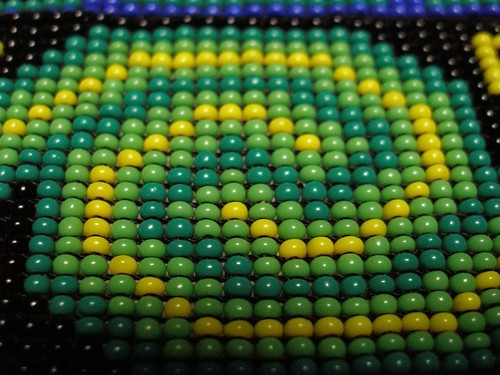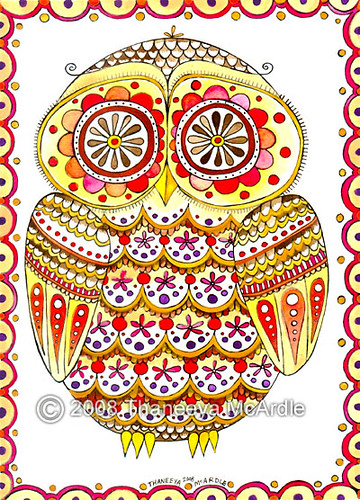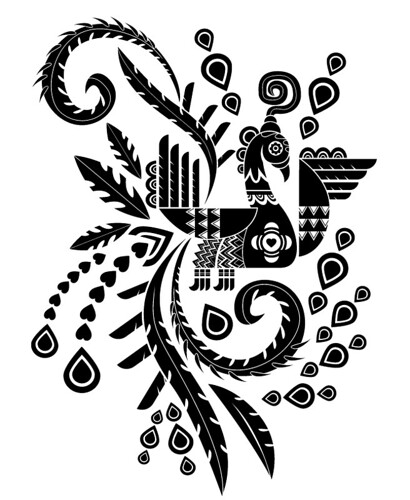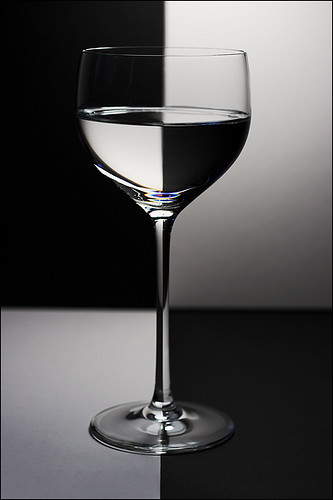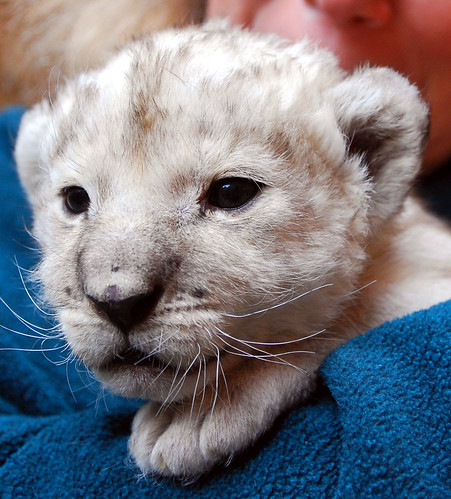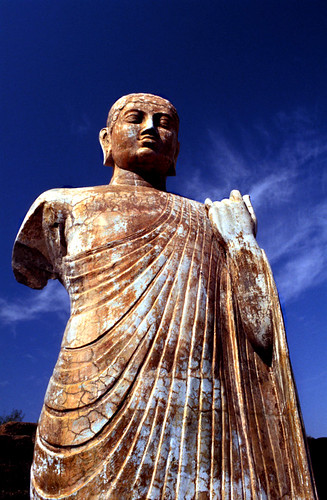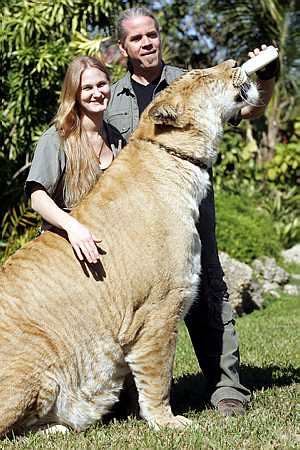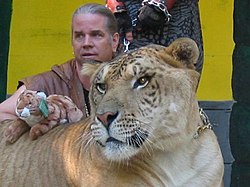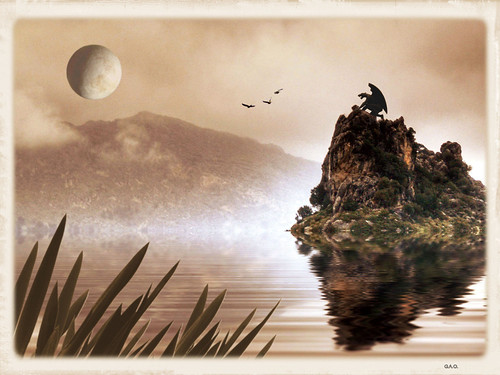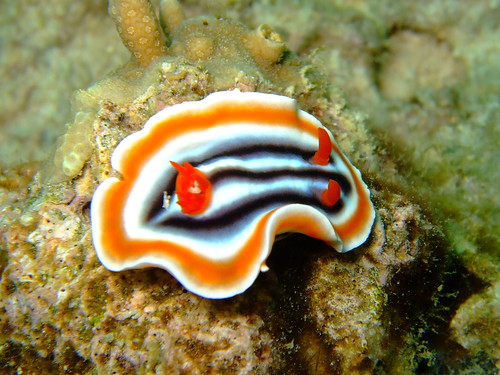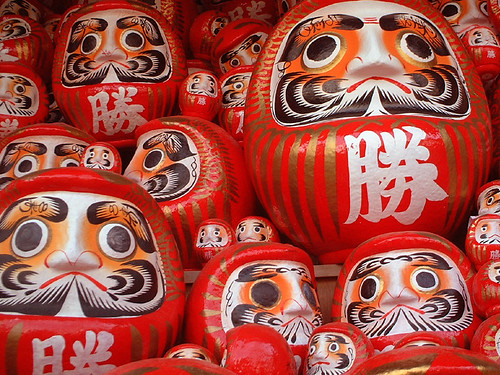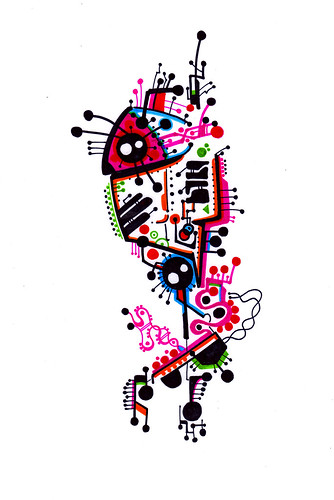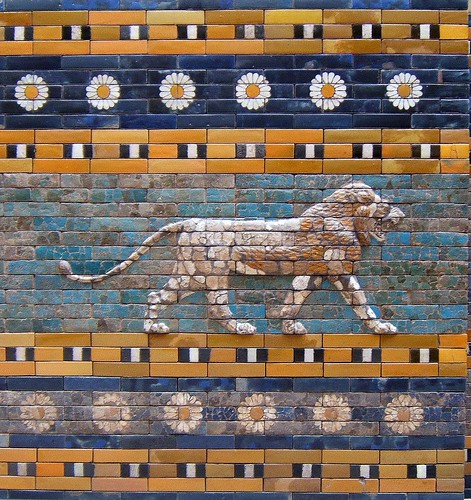.
. .
. . .
. . . .
. . . . .
. . . . . .
. . . . .
. . . .
. . .
. .
.
lunes, diciembre 15, 2008
. . .
martes, diciembre 09, 2008
viernes, diciembre 05, 2008
GAUDI'S VIGILANTS
martes, noviembre 25, 2008
jueves, noviembre 06, 2008
lunes, noviembre 03, 2008
martes, octubre 21, 2008
jueves, octubre 16, 2008
ART - PINEAL GLAND - MONAD
René Descartes, who dedicated much time to the study of the pineal gland, called it the "seat of the soul" . He believed that it was the point of connection between the intellect and the body.
ART - PINEAL GLAND - MONAD
lunes, octubre 13, 2008
BIG BUDDHA
On Bophut beach, Samui.
Wat Phra Yai lies in Samui’s northeast, on route 4171 near the airport. 3xpHDR.
BIG BUDDHA
lunes, octubre 06, 2008
INDIA
viernes, octubre 03, 2008
viernes, septiembre 12, 2008
STAIRWAY TO HEAVEN

Stairway to Heaven, originalmente cargada por Nikα Fαdul.
...always love U my dear C O N T R A P O E T A...
STAIRWAY TO HEAVEN
ROAD TO HEAVEN
For everything there is a season,
And a time for every matter under heaven:
A time to be born, and a time to die;
A time to plant, and a time to pluck up what is planted;
A time to kill, and a time to heal;
A time to break down, and a time to build up;
A time to weep, and a time to laugh;
A time to mourn, and a time to dance;
A time to throw away stones, and a time to gather stones together;
A time to embrace, And a time to refrain from embracing;
A time to seek, and a time to lose;
A time to keep, and a time to throw away;
A time to tear, and a time to sew;
A time to keep silence, and a time to speak;
A time to love, and a time to hate,
A time for war, and a time for peace.
Ecclesiastes 3:1-8
ROAD TO HEAVEN
jueves, septiembre 04, 2008
L I G E R
Yes, Ligers are real...
I didn't take this one.
| Liger | ||||||||||||
|---|---|---|---|---|---|---|---|---|---|---|---|---|
 | ||||||||||||
| Scientific classification | ||||||||||||
|
L I G E R
THE LARGEST CAT IN THE WORLD :)

The Liger is a hybrid cross between a male lion and a female tiger (i.e, Panthera leo × Panthera tigris). A liger resembles a tiger with diffused stripes. They are the largest cats in the world, although the Siberian Tiger is the largest "pure" taxon. Ligers and tigers enjoy swimming, whereas lions do not. A similar hybrid, the offspring of a male tiger and a female lion is called a tigon.
Documentation of ligers dates to at least the early 19th century in Asia. A painting of two liger cubs was made by Étienne Geoffroy Saint-Hilaire (1772−1844). In 1825, G.B. Whittaker made an engraving of liger cubs born in 1824. The parents and their three liger offspring are also depicted with their trainer in a 19th Century painting in the naïve style.
Two liger cubs born in 1837, were exhibited to William IV and to his successor Victoria. On 14 December 1900 and on 31 May 1901, Carl Hagenbeck wrote to zoologist James Cossar Ewart with details and photographs of ligers born at the Hagenbeck's Tierpark in Hamburg in 1897.
In Animal Life and the World of Nature (1902–1903), A.H. Bryden described Hagenbeck's "lion-tiger" hybrids:
It has remained for one of the most enterprising collectors and naturalists of our time, Mr Carl Hagenbeck, not only to breed, but to bring successfully to a healthy maturity, specimens of this rare alliance between those two great and formidable felidae, the lion and tiger. The illustrations will indicate sufficiently how fortunate Mr Hagenbeck has been in his efforts to produce these hybrids. The oldest and biggest of the animals shown is a hybrid born on the 11th May, 1897. This fine beast, now more than five years old, equals and even excels in his proportions a well-grown lion, measuring as he does from nose tip to tail 10 ft 2 inches in length, and standing only three inches less than 4 ft at the shoulder. A good big lion will weigh about 400 lb [...] the hybrid in question, weighing as it does no less than 467 lb, is certainly the superior of the most well-grown lions, whether wild-bred or born in a menagerie. This animal shows faint striping and mottling, and, in its characteristics, exhibits strong traces of both its parents. It has a somewhat lion-like head, and the tail is more like that of a lion than of a tiger. On the other hand, it has no trace of mane. It is a huge and very powerful beast.
In 1935, four ligers from two litters were reared in the Zoological Gardens of Bloemfontein, South Africa. Three of them, a male and two females, were still living in 1953. The male weighed 750 lb. and stood a foot and a half taller than a full grown male lion at the shoulder.
Imprinted genes may be a factor contributing to liger size. These are genes that may or may not be expressed on the parent they are inherited from, and that occasionally play a role in issues of hybrid growth. For example, in some dog breed crosses, genes that are expressed only when maternally-inherited cause the young to grow larger than is typical for either parent breed. This growth is not seen in the paternal breeds, as such genes are normally "counteracted" by genes inherited from the female of the appropriate breed.
The tiger produces a hormone that sets the fetal liger on a pattern of growth that does not end throughout its life. The hormonal hypothesis is that the cause of the male liger's growth is its sterility — essentially, the male liger remains in the pre-pubertal growth phase. Male ligers also have the same levels of testosterone on average as an adult male lion. In addition, female ligers also attain great size, weighing approximately 700 lb (320 kg) and reaching 10 feet (3.05 m) long on average, and are often fertile.

Jungle Island in Miami is home to a liger named Hercules, the largest non-obese liger, said to weigh over 1100 lbs, over twice the size of a male lion. Hercules was also featured on the Today Show, Good Morning America, Anderson Cooper 360, Inside Edition and in a Maxim magazine article in 2005, when he was only 3 years old and already weighed 408.25 kg (900 lb) at the time.[citation needed] The liger is the largest animal in the cat family (feline family Felidae); and Hercules was in the Book of World Records as the largest cat. Hercules seems completely healthy and is expected to live a long life. The cat's breeding is said to have been a complete accident. Sinbad, another Liger, was shown on the National Geographic Channel. Sinbad was reported to have the exact weight of Hercules.
Shasta, a ligress (female liger) was born at the Hogle Zoo in Salt Lake City on May 14th, 1948 and died in 1972 at age 24. The 1973 Guinness world records reported an 18-year-old, 1000-kg (2200 lb) male liger living at Bloemfontein zoological gardens, South Africa, in 1888. Valley of the Kings animal sanctuary in Wisconsin had a male liger named Nook who weighed around 550 kg (1210 lb), and passed away in 2007, at 21 years old.
While male ligers are sterile, female ligers can usually reproduce. Because only female ligers and tigons are fertile, a liger cannot reproduce with another liger or with a tigon. The offspring from a coupling of a female liger and a male tiger is referred to as a ti-liger, while the offspring produced from a female liger and a male lion is referred to as a li-liger.
The fertility of hybrid big cat females is well-documented across a number of different hybrids. This is in accordance with Haldane's rule: in hybrids of animals whose gender is determined by sex chromosomes, if one gender is absent, rare or sterile, it is the heterogametic sex (the one with two different sex chromosomes e.g. X and Y).
According to Wild Cats of the World (1975) by C. A. W. Guggisberg, ligers and tigons were long thought to be sterile: In 1943, however, a fifteen-year-old hybrid between a lion and an 'Island' tiger was successfully mated with a lion at the Munich Hellabrunn Zoo. The female cub, although of delicate health, was raised to adulthood.
Ligers have a tiger-like striping pattern on a lion-like tawny background. In addition they may inherit rosettes from the lion parent (lion cubs are rosetted and some adults retain faint markings). These markings may be black, dark brown or sandy. The background color may be correspondingly tawny, sandy or golden. In common with tigers, their underparts are pale. The actual pattern and color depends on which subspecies the parents were and on the way in which the genes interact in the offspring.
White tigers have been crossed with lions to produce "white" (actually pale golden) ligers. In theory white tigers could be crossed with white lions to produce white, very pale or even stripeless ligers. A black liger would require both a melanistic tiger and a melanistic lion as parents. Very few melanistic tigers have ever been recorded, most being due to excessive markings (pseudo-melanism or abundism) rather than true melanism. No reports of black lions have ever been substantiated. A hypothetical procedure to breed black ligers is explained here. The blue or Maltese Tiger is now unlikely to exist, making gray or blue ligers an impossibility. It is not impossible for a liger to be white, but it is very rare.
According to the Association of Zoos and Aquariums, accredited zoos frown on the practice of mixing two different species and have never bred ligers. Keeping the two species separate has always been standard procedure.However they have admitted that ligers have occurred by accident. Several AZA zoos are reported to have ligers.
- In the 2004 movie Napoleon Dynamite, the title character draws a picture of a liger. Describing the hybrid felid as "pretty much my favorite animal," he asserts that the liger has been bred for "its skills in magic." However, the animal he draws resembles a manticore more than a liger.
- Several fictional mecha from the Zoids model and anime franchise are described as Liger types: most notably, the Shield Liger, Blade Liger, and Liger Zero. Ligers are nearly always the zoid used by the main characters in the series.
- The Hogle Zoo in Salt Lake City, Utah had a liger which was born on May 14, 1948 and died in 1972.
- Jimmy Graham, basketball player for the Miami Hurricanes, was nicknamed "Liger" by Head Coach Frank Haith.
THE LARGEST CAT IN THE WORLD :)
martes, septiembre 02, 2008
sábado, agosto 23, 2008
MARÍA DEL ROSARIO ESPINOZA
Maria del Rosario Espinoza (red) of Mexico fights against Nina Solheim of Norway during the Taekwondo women +67kg Gold medal contest at the Beijing Olympic Games in Beijing, China, Aug. 23, 2008. Maria del Rosario Espinoza defeated Nina Solheim and won the gold medal.
Foto cortesía de Mexsport.
MARÍA DEL ROSARIO ESPINOZA
¡DIOSA DE ORO!
María del Rosario Espinoza, taekwondoín mexicana ganadora de la medalla de oro en la categoría de +67 kilogramos al vencer a la noruega Nina Solheim por 3-1 puntos.
Mexico has now taken two gold here as Guillermo Perez also won the men's 58kg event. 'The Beijing Olympic Games are one of the greatest Olympic Games in the history of Mexican taekwondo because we have got two gold medals here,' said Del Rosario Espinoza. 'For Mexico, it's a historical breakthrough. For me, this gold medal means a lot because of my hard training over the years.'
¡DIOSA DE ORO!
jueves, agosto 21, 2008
LEOPARD - PANTHERA PARDUS
Fast Fact.
Type: Mammal
Diet: Carnivore
Protection status: Endangered
The leopard is so strong and comfortable in trees that it often hauls its kills into the branches. By dragging the bodies of large animals aloft it hopes to keep them safe from scavengers such as hyenas. Leopards can also hunt from trees, where their spotted coats allow them to blend with the leaves until they spring with a deadly pounce. These nocturnal predators also stalk antelope, deer, and pigs by stealthy movements in the tall grass. When human settlements are present, leopards often attack dogs and, occasionally, people.
This species was originally distributed throughout the Korean Peninsula, northeastern China, and the Amur River Valley on the Russia-China border and southeastern Russia; the majority of its range overlapping with that of the Siberian Tiger. It also is rarely found in warm areas. Today, it is extremely close to extinction with only 25 to 34 known individuals remaining in the Sikhote-Alin mountains of southern Russia (only six of these are female), while it is estimated that at least 100 are needed if the species is to avoid extinction. A few individuals are thought to remain on the Kaema Plateau and Baekdusan of North Korea, but the status of the species here is unknown. Habitat destruction and the fur trade have diminished its numbers dramatically, and have resulted in the animal becoming the rarest extant member of the feline family on the planet. It has also been suggested that poachers interested in the Leopard's fur and meat helped bring about the Amur Leopard's downfall but there is no solid evidence to support this.
http://en.wikipedia.org/wiki/Amur_Leopard
LEOPARD - PANTHERA PARDUS
DESERT SCARAB
...so, I couldn't really work on anything last week
due to work...that job shit really gets in the way
sometimes doesn't it?...anyway, I was going through
drawing withdrawls the other night and forced myself
to crack open the 'ole moleskine...
...here's what I learned..and I may be repeating myself
here...whenever I draw a picture from a photograph,
though I may like the end result, it doesn't give me
the same feeling that I get when I draw something
from my imagination. But, for some reason, that
doesn't apply when drawing from life....be it a still
life or something outside...drawing from life still
seems like your "creating" something..I mean, you pick
your view, your angle, etc...
..anyway, to make a long story short, ..when drawing
from a photo, I may like the asthetic when I'm
finished , but the feeling of accomplishment is
lesser than something I've created from my imagination.
..I would love to hear your thoughts on this..
...oh, this was done in my small Moleskine reporter with ink and watercolor....the
thin sheets of the moleskine really can take some abuse.
DESERT SCARAB
AVALON SUNRISE
Here another shot of my favourite rocks at the moment. It was a bit of a shame to not get more light trails off the sun but maybe next time.

 Geoffrey of Monmouth interpreted the name as the "isle of apples". This is probable, as "apple" is still aval in Breton and Cornish, and afal in Welsh, in which the letter f is pronounced [v]. Another possibility — the Abalus mentioned by Pytheas — the island of amber — which could have non-Celtic origins. (see more about the Abalus possibility below)
Geoffrey of Monmouth interpreted the name as the "isle of apples". This is probable, as "apple" is still aval in Breton and Cornish, and afal in Welsh, in which the letter f is pronounced [v]. Another possibility — the Abalus mentioned by Pytheas — the island of amber — which could have non-Celtic origins. (see more about the Abalus possibility below)In the seventeenth century the Province of Avalon was the area around the settlement of Ferryland which upon the success of the colony grew to include the land held by Sir William Vaughan and all the land that lay between Ferryland and Petty Harbour.
Sir George Calvert had acquired a piece of Newfoundland and hired an agent Captain Edward Wynne to set up headquarters in Ferryland. The area he termed The Colony of Avalon in honour of "old Avalon...the first-fruits of Christianity in Britain." In 1620 Calvert obtained a grant from Sir William Vaughan for all of the land that lay north of a point between Fermeuse and Aquaforte to as far north as Caplin Bay (now Calvert) on the southern shore of the Avalon Peninsula.
http://en.wikipedia.org/wiki/Avalon
AVALON SUNRISE
THE AVALON GUARDIAN
"HIC IACET SEPULTUS INCLITUS REX ARTURIUS IN INSULA AVALONIA"
"Here lies buried the renowned King Arthur in the Isle of Avalon"
According to Geoffrey and much subsequent literature, Avalon is the place where King Arthur was taken after fighting Mordred at the Battle of Camlann. Welsh and Breton tradition claimed that Arthur had never really died, but would inexorably return to lead his people against their enemies, but some later writers were less credulous, and said that Arthur had in fact died there. Geoffrey dealt with Avalon again in his Vita Merlini, in which he describes the character Morgan le Fay as the chief of nine sisters who live on Avalon. Morgan remained associated with the island in later literature, as does Arthur's mentor, the Lady of the Lake.
By the 12th century Avalon became associated with Glastonbury, when monks at Glastonbury Abbey claimed to have discovered the bones of Arthur and his queen. Though no longer an island at the time, the high conical bulk of Glastonbury Tor had been surrounded by marsh before the surrounding fenland in the Somerset Levels was drained. According to later chroniclers, notably Giraldus Cambrensis, during King Henry II's reign the abbot of Glastonbury, Henry of Blois, commissioned a search of the abbey grounds. At a depth of 5 m (16 feet) the monks discovered a massive oak coffin and an iron cross bearing the description: Hic jacet sepultus inclitus rex Arthurus in insula Avalonia. ("Here lies renowned King Arthur in the island of Avalon"). Inside the coffin were two bodies, who Giraldus refers to as Arthur and "his queen". In 1278 the remains were reburied with great ceremony, attended by King Edward I and his queen, before the High Altar at Glastonbury Abbey, where they were the focus of pilgrimages until the Reformation. However, historians generally dismiss the authenticity of the find, attributing it to a publicity stunt performed to raise funds to repair the Abbey, which was mostly burned down in 1184.
Other theories point to l'Île d'Aval or Daval, on the coast of Brittany, and Burgh by Sands, in Cumberland, which was in Roman times the fort of Aballava on Hadrian's Wall, and near Camboglanna, upwards on the Eden, now Castlesteads. Coincidentally, the last battle site of Arthur's campaigns is said to have been named Camlann. Other candidates include the Bourgogne town of Avallon, suggested by Geoffrey Ashe and Bardsey Island in Gwynedd, famous for its apples and also connected with Merlin. Others have claimed the most likely location to be St Michael's Mount in Cornwall, which is near to other locations associated with the Arthurian legends. St Michael's Mount is an island which can be reached by a causeway at low tide. The matter is confused somewhat by similar legends and place names in Britanny.
Possible assumption by Geoffrey that Pytheas' Abalus was near Britain: The ancient Greek traveller Pytheas, who travelled to Britain around 320BC and then to an island called "Thule", considered today to have been Iceland, also went to where amber was collected; and he wrote the island was called Abalus or Abalum. While it is likely from evidence beyond the scope of this discussion, that Pytheas visited the southeast Baltic region which was the main source of trade amber and that the "island" was actually the Samland Peninsula which is filled with amber still, it is possible that Geoffrey - whose work was very inventive and creative to say the least - read the Latin texts about Pytheas travels, and arbitrarily assumed Abalus was near Britain, like Thule and felt compelled to include it in his creative embellishments and expansions of the Arthurian myths.
http://en.wikipedia.org/wiki/Avalon
THE AVALON GUARDIAN
lunes, agosto 18, 2008
NUDIBRANCH - WATER MONAD
LOVE IN EKILIBRIUM
GNARLS BARKLEY 'CRAZY'
GNARLS BARKLEY - CRAZY
there was something so pleasant about that place, Even your emotions have an echo, In so much space.
And when you`re out there, Without care, Yeah, I was out of touch, but it wasn`t because I didn`t know enough, I just knew too much.
Does that make me crazy
Does that make me crazy
Does that make me crazy
Possibly
Come on now , who do you, who do you, who do you, who do you think you are, Ha ha ha bless your soul, You really think you`re in control.
Well, I think you`re crazy,
I think you`re crazy
I think you`re crazy
Just like me
Ever since I was little, ever since I was little Oh it looked like fun, and it`s no coincidence I`ve come, And I can die when I`m done.
But maybe I`m crazy,
Maybe you`re crazy,
Maybe we`re crazy,
Probably
GNARLS BARKLEY 'CRAZY'
EVENING CLOUDS 3D

Evening clouds 3D, originalmente cargada por Dan (aka firrs).
View over the Solway Firth. This is an anaglyph stereoscopic image. You need to wear red-cyan glasses to view in 3D.
There is a non-3D version here:
www.flickr.com/photos/firrs/2474621254/
And cross view 3D versions here:
www.flickr.com/photos/firrs/2672109742/
www.flickr.com/photos/firrs/2676971438/
EVENING CLOUDS 3D
WINNING DARUMA (TUMBLING DOLL)
jueves, agosto 07, 2008
THE OFFICIAL MASCOTS - BEIJING 2008
| Fuwa | |
|---|---|
| The Fuwa | |
| Chinese: | 福娃 |
| Literal meaning: | dolls of blessing |
The Fuwa (Chinese: 福娃; pinyin: Fúwá; literally "good-luck dolls" and can be known as "Friendlies"), are the mascots of the 2008 Summer Olympics in Beijing. The designs were created by Han Meilin, a famous Chinese artist. The designs were publicly announced by the National Society of Chinese Classic Literature Studies on November 11, 2005 at an event marking the 1000th day before the opening of the games.
There are five fuwa: Beibei, Jingjing, Huanhuan, Yingying, and Nini. Together, the names form the sentence "北京欢迎你", Běijīng huānyíng nǐ which means "Beijing welcomes you". Originally named 'The Friendlies', they were promoted as 'Fuwa' when there were concerns the name could be misinterpreted.
http://en.wikipedia.org/wiki/Fuwa
THE OFFICIAL MASCOTS - BEIJING 2008
NINI (福娃妮妮)
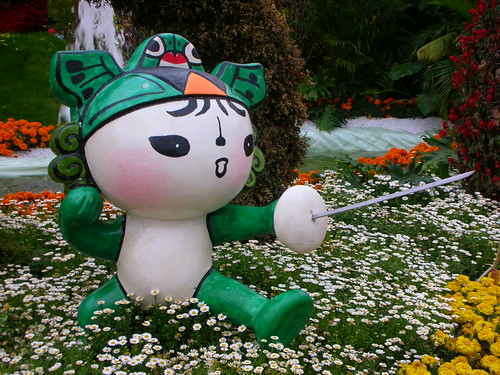
The Official Mascots of the Beijing 2008 Olympic Games - Nini (福娃妮妮), originalmente cargada por ma vie, mes photos.
Cultural inspiration: The swallow; Beijing's shayan kites.
Olympic Ring: Green
Represented Element: Sky
Actual Fengshui Element: Metal
Personality: Innocent, kind
Represented ideal: Good fortune
Represented sport: gymnastics
http://en.wikipedia.org/wiki/Fuwa
NINI (福娃妮妮)
JINGJING (晶晶)
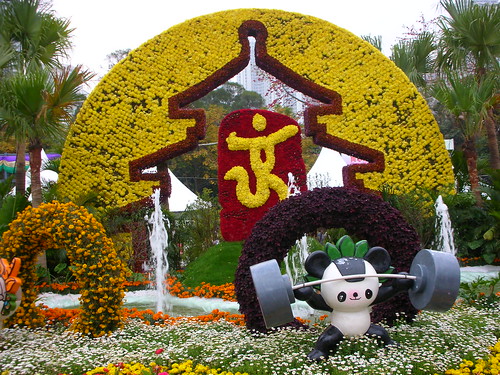
DSCN9930, originalmente cargada por ma vie, mes photos.
Cultural inspiration: Giant panda; Song Dynasty lotus-shaped porcelain.
Olympic Ring: Black
Represented Elemen: Forest
Actual Fengshui Element: Wood
Personality: Honest, optimistic
Represented ideal: Happiness
Represented sport: weightlifting, judo, etc.
http://en.wikipedia.org/wiki/Fuwa
JINGJING (晶晶)
miércoles, agosto 06, 2008
ALIADO (ALLIE - INORGANIC BEINGS) AI A9 - MONAD
You're gonna, gonna, gonna, gonna get it right!- Yes Tormato
Straight jacket, freedom's march, is it all, far beyond
Our reason of understanding
Campaign everything, anti-right, anti-left
Anticipate the love of creation
Stand for every right
Kick it out, hear you shout
Further the right
Further the right
Further the right
Of all of creation
ALIADO (ALLIE - INORGANIC BEINGS) AI A9 - MONAD
martes, agosto 05, 2008
I LOVE PEACE
Last summer, I occasionally saw this lovely girl with a beautiful pigeon on the street in Beijing. Very cute! At that time I happened to have a camera, and then I immediately took these photos. However, due to time constraints, I was unable to adjust my camera to an appropriate state before shooting, so these photos have a particular stress on red color . Today is "International Children’s Day", I send these photos to children with my best wishes!
Any critiques and suggestions on this are most welcome.
I LOVE PEACE
THE PERGAMON MUSEUM - ISHTAR GATE
Lion frieze, Ishtar Gate, Pergamon Museum, Berlin
The Pergamon Museum (in German, Pergamonmuseum) is among the museums on Museum Island in Berlin. The site was designed by Alfred Messel and Ludwig Hoffmann and was built from 1910 to 1930. The Pergamon houses original-sized, reconstructed monumental buildings such as the Pergamon Altar, the Market Gate of Miletus, and the Ishtar Gate, all consisting of parts transported from the original excavation sites.
The museum is subdivided into the antiquity collection, the Middle East museum, and the museum of Islamic art. The museum is visited by approximately 850,000 people every year, making it the most visited art museum in Germany (2006).
By the time the Kaiser-Friedrich-Museum on Museum Island (today the Bodemuseum) had opened, it was clear that the museum was not large enough to host all of the art and archaeological treasures excavated under German supervision. Excavations were underway in Babylon, Uruk, Assur, Miletus, Priene and Egypt, and objects from these sites could not be properly displayed within the existing German museum system. As early as 1907, Wilhelm von Bode, the director of the Kaiser-Friedrich-Wilhelm-Museum had plans to build a new museum nearby to accommodate ancient architecture, German post-antiquity art, and Middle Eastern and Islamic art.
This large three-wing museum had been in planning since 1907; when Alfred Messel died in 1909 his close friend Ludwig Hoffman took charge of construction, which began in 1910. The construction continued during the First World War (1918) and the great inflation of the 1920s. In 1930 the building hosting the four museums opened.
The Pergamon Museum was severely damaged during the air attack on Berlin at the end of the Second World War. Many of the display objects were stored in safe places, and some of the large pieces were walled in for protection. In 1945, the Red Army collected all of the loose museum items, either as war booty or, ostensibly, to rescue them from looting and fires then raging in Berlin. Not until 1958 were most of the objects returned to East Germany. Significant parts of the collection remain in Russia. Some are currently stored in the Pushkin Museum in Moscow and the Hermitage in Saint Petersburg. The return of these items has been arranged in a treaty between Germany and Russia but, as of June 2003, is blocked by Russian restitution laws.
Among the great pieces the museum displays are:
- The Pergamon Altar
- Market Gate of Miletus
- The Ishtar Gate and the Processional Way, Babylon
- The Mshatta facade
The Antiquity Collection (Antikensammlung)
The collection goes back to the Electors, or Kurfürsten, of Brandenburg, who collected objects from antiquity; the collection began with an acquisition to the collection by a Roman archaeologist in 1698. It first became accessible (in part) to the public in 1830, when the Altes Museum was opened. The collection expanded greatly with the excavations in Olympia, Samos, Pergamon, Miletus, Priene, Magnesia, Cyprus and Didyma.
This collection is divided between the Pergamon Museum and the Altes Museum.
The collection contains sculpture from archaic to Hellenistic ages as well as artwork from Greek and Roman antiquity: architecture, sculptures, inscriptions, mosaics, bronzes, jewelry and pottery
The main exhibits are the Pergamon Altar from the 2nd century BC, with a 113 meters (371 ft) long sculptural frieze depicting the struggle of the gods and the giants, and the Gate of Miletus from Roman antiquity.
As Germany was divided following the Second World War, so was the collection. The Pergamon Museum was reopened in 1959 in East Berlin, while what remained in West Berlin is on display in the Castle of Charlottenburg since 1995.
THE PERGAMON MUSEUM - ISHTAR GATE



